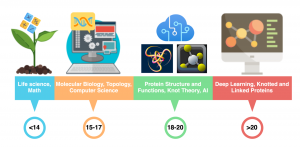Since very young, I have been a research-motivated person. I’m especially intrigued by the various phenomena in nature – the visible ones like human diseases and the invisible ones like Molecular Biology. My dream is to be an interdisciplinary researcher, deploying mathematical modeling and machine learning to investigate protein structures and functions. The following story elaborates on the development of my research interests.
My passion for biology began with Mendel’s pea plant experiments. For a very long time, the “ATGC” sequence and amino acids in the NCBI variation viewer peaked my interest. Desiring to learn more about NCBI, I used to spend hours watching YouTube tutorials and exploring the tools in the database while I was back in secondary school.
In 2018, at the DNA topology lab at UC Davis, I was introduced to Knot Theory, C++, and Matlab. I soon realized that computer science could bridge the gap between biology and math. Employing Java, Phyre2 (a protein structure prediction server), and KnotPlot (a topology software), I participated in a research project titled “Topological Analysis of Protein Folding of LRRK2 Mutants in Parkinson’s Disease” to analyze the topological features of pathogenic Leucine-rich repeat kinase 2 (LRRK2) mutants.
From this experience, I not only learned to look for mutations in the NCBI Variation Viewer and to write programs in KnotPlot, but also became aware of how tedious the analysis process was when performed manually. Since then, I have been determined to develop an automated method for the identification of knots and links in proteins. To facilitate this process, I started to reach out to professionals in the field and search for presentation opportunities to communicate my ideas.
In 2018 October, I was invited to a poster presentation as the only high school student at World Life Science Conference where I was offered with the chance to learn from senior scientists in a variety of fields. These conversations with experts, including some from London, motivated me to major in Biology. In the following year, my family and teachers supported my decision of skipping high school senior year and joining the Biochemical Engineering undergraduate program at UCL.
At UCL Biochemical Engineering department, modules in Proteomics, Biochemistry, Molecular Biology, and Cell Biology enhanced my overall understanding in Biosciences. Modules in Modeling, the research experience at UCL iGEM, as well as my minor in Intelligent Systems at UCL Computer Science Department improved my computational skills. UCL helped me establish a solid foundation for my research in knotted proteins.
Now as a Year 3 PhD candidate in Computational Biology and Bioinformatics at Yale University, I’m still pursuing the science research dream I had as a teenager, but with more abundant resources and skills. I’m super keen on applying Deep Learning and Topology to protein design.


